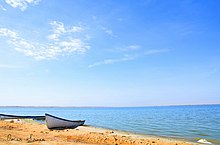
Back معركة عين التمر Arabic عینالتمر دؤیوشو AZB نبرد عینالتمر Persian Pertempuran Ain Al-Tamur ID Battaglia di 'Ayn al-Tamr Italian Perang Ainul Tamar Malay عین التمر دی لڑائی PNB Битва при Айн Тамре Russian Битка код Ајн Тамра Serbian Битва при Айн Тамрі Ukrainian
32°33′58.0″N 43°29′25.4″E / 32.566111°N 43.490389°E
| Battle of Ayn al-Tamr | |||||||||
|---|---|---|---|---|---|---|---|---|---|
| Part of Muslim conquest of Persia and Campaigns of Khalid ibn al-Walid | |||||||||
 Al-Razzaza Lake in Ain Al-Tamr | |||||||||
| |||||||||
| Belligerents | |||||||||
| Rashidun Caliphate |
Sasanian Empire[1] Arab Christians[2] | ||||||||
| Commanders and leaders | |||||||||
| Khalid ibn al-Walid |
Mihran Bahram-i Chubin (MIA) Aqqa ibn Qays ibn Bashir (POW), later executed | ||||||||
| Strength | |||||||||
| 500–800[Notes 1][6] | Unknown number, although it consisted of a "great" following of Arab Christian tribes and Sassanian "mobile troops". At least tens of thousand[3] | ||||||||
| Casualties and losses | |||||||||
| Unknown |
Entire field army executed Persian garrison defenders of the town slaughtered[4] | ||||||||
The Battle of Ayn al-Tamr (Arabic: معركة عين التمر) took place in modern-day Iraq (Mesopotamia) between the early Muslim Arab forces and the Sassanians along with their Arab Christian auxiliary forces. Ayn al-Tamr is located west of Anbar and was a frontier post which had been established to aid the Sassanids.[7]
The Muslims under Khalid ibn al-Walid's command soundly defeated the Sassanian auxiliary force, which included large numbers of non-Muslim Arabs who broke earlier covenants with the Muslims.[8] According to William Muir, Khalid ibn al-Walid captured the Arab Christian commander, Aqqa ibn Qays ibn Bashir, with his own hands,[9] which matched the accounts of both Ibn Atheer in his Usd al-ghabah fi marifat al-Saḥabah, and Tabari in his Tarikh.[3][4]
- ^ Annals of the Early Caliphate by William Muir pg. 85
- ^ Iraq After the Muslim Conquest by Michael G. Morony, pg 224
- ^ a b c d Ibn Atheer.
- ^ a b c Tabari 1993, p. 53-54.
- ^ Tabari 1993, p. 55.
- ^ a b Baladhuri 2011, p. 169.
- ^ The Caliph's Last Heritage: A Short History of the Turkish Empire by Mark Sykes
- ^ The Book of Revenue: Kitab Al-Amwal by Abu 'Ubayd Al-Qasim Ibn Sallam, pg 194
- ^ Muir 1883, p. 62.
Cite error: There are <ref group=Notes> tags on this page, but the references will not show without a {{reflist|group=Notes}} template (see the help page).